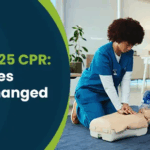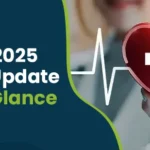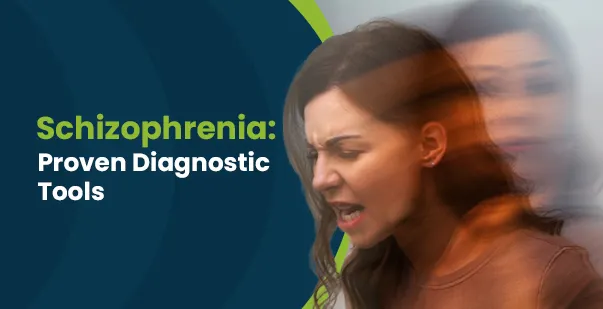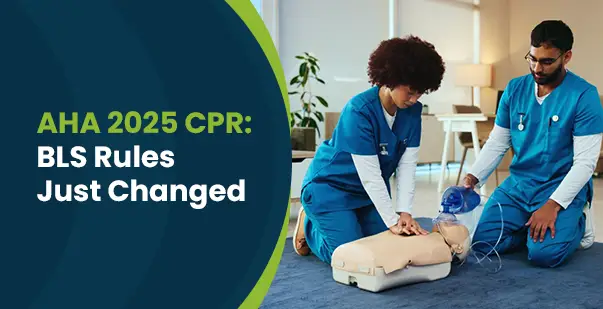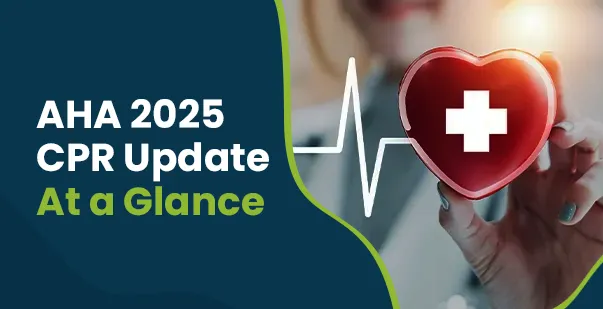Have you ever felt like your mind was playing tricks on you? Hearing whispers no one else hears or seeing things that vanish in a blink? For some individuals, this isn’t just a brief fear; it’s their regular actuality. Schizophrenia is an intricate cognitive health illness. It profoundly impacts the path an individual believes, judges, and interacts with their surroundings. Some people may hear voices that others cannot hear, believe things that are not true, struggle to express emotions or find it difficult to stay organized.
Schizophrenia is tricky to diagnose because there’s no single test for it. Instead, doctors follow a step-by-step process. They carefully review symptoms, terminate other ailments, and employ various tools to guarantee a precise diagnosis. In this article, we will analyze the diagnostic method of schizophrenic individuals, including the standards physicians use and the tools they depend on for exact judgments.
5 Steps in Diagnosing Schizophrenia
Schizophrenia affects about 24 million people worldwide, which is approximately 1 in 300 individuals (0.32%).
Diagnosing schizophrenia is a complex process that requires comprehensive evaluation. Doctors follow a series of steps to understand the patient’s symptoms, rule out other conditions, and confirm the diagnosis.
Early diagnosis helps in providing effective treatment and better management of the condition. Here are some common steps followed in diagnosing schizophrenia:
1. Initial Assessment
The first step in diagnosing schizophrenia involves a clinical assessment, where the doctor talks to the patient to understand their symptoms and experiences. Schizophrenia often causes hallucinations, where a person hears or sees things that are not real, and delusions, where a person strongly believes in something false or unrealistic. However, not every person who has schizophrenia experiences hallucinations. Some people also have disorganized thoughts or feel no emotions.
Since schizophrenia affects daily life, the doctor may ask if the patient is facing difficulties at work, school, or in social situations. The doctor might also ask certain questions like “Do you get to hear voices that others cannot? or “Do you feel as if someone is watching you?” during the assessment. Family members may be involved in the assessment, as they can provide valuable information about the patient’s behavior and changes over time.
Schizophrenia is diagnosed only if symptoms last for at least six months. The doctor carefully notes the duration and impact of the symptoms of the person living with schizophrenia before moving to the next step.
2. Medical History and Physical Exam
A detailed medical history helps doctors rule out any other conditions causing the symptoms. For this, the doctor typically reviews past illnesses, as some medical conditions can mimic schizophrenia symptoms. If a parent or sibling has schizophrenia, the chances of developing it are higher. Additionally, the doctor checks if the patient has used drugs or alcohol, as substance abuse can cause hallucinations and delusions.
Next, a physical exam is conducted to specify any underlying health issues. For instance, some neurological disorders, infections, or hormonal imbalances can cause similar symptoms to schizophrenia. If an underlying medical ailment is uncovered, the physician may suggest further tests or medicines before verifying schizophrenia. Furthermore, certain conditions mimic schizophrenia, such as
- Schizoaffective Disorder,
- Bipolar Disorder (Manic or Psychotic Depression Episodes),
- Substance-Induced Psychosis,
- Major Depressive Disorder with Psychotic Features,
- Dissociative Disorders (Dissociative Identity Disorder – DID),
- Neurological Disorders like Epilepsy, Brain Tumors, Dementia, or Huntington’s Disease.
3. Mental Health Evaluation
A psychiatrist or psychologist conducts a thorough mental health assessment to examine speech patterns, thought processes, and emotional reactions to different situations.
Schizophrenia often affects memory, attention, and emotional responses. The doctor checks if the patient’s thoughts are logical or disorganized. Disorganized thinking, a key symptom of schizophrenia, can make communication difficult.
During this specific evaluation, the patient is requested to depict their ventures, sentiments, and even fears. Structured interviews, such as SCID (Structured Clinical Interview for DSM-5) and standardized questionnaires, help in collecting additional information. The doctor also evaluates whether the patient is mindful of their situation. Many people with schizophrenia are clueless that their ideas and perceptions are slanted. This makes diagnosis and even treatment more demanding. This incapability to recognize one’s own mental illness is known as a ‘lack of insight,’ a symptom called anosognosia.
4. Diagnostic Criteria Check
To confirm schizophrenia, doctors follow the guidelines in the Diagnostic and Statistical Manual of Mental Disorders (DSM-5). This manual provides specific criteria for diagnosis. According to DSM-5, a person must have at least two of the following five symptoms:
- Delusions: These are strong false beliefs that do not change even when proven wrong.
- Hallucinations: Hallucinations involve seeing, hearing, or feeling things that are not real.
- Disorganized Speech: Disorganized speech makes it hard for the person to communicate properly. Their words may not make sense or jump between topics quickly.
- Disorganized or abnormal movement: These movements include strange body postures, sudden agitation, or a complete lack of movement.
- Negative Symptoms: These include reduced speech, lack of facial expressions, and withdrawal from social activities.
- Memory Issues: People struggling with memory problems may find it difficult to remember important details, conversations, or recent events. They might forget appointments, misplace items frequently, or have trouble recalling information they once knew well.
- Difficulty in Focusing: Concentration problems can make it hard for someone to stay engaged in tasks or conversations. They may become easily distracted, struggle to follow instructions or find it challenging to finish what they started.
To confirm the diagnosis, DSM-5 requires at least two of the five symptoms mentioned above, one of which must be delusions, hallucinations, or disorganized speech. These symptoms must cause significant problems in daily life and have continued for at least six months. If they have appeared for a shorter period, the diagnosis may be uncertain, and the doctor may wait for further observation.
5. Ruling Out Other Disorders
Schizophrenia symptoms often overlap with other mental health conditions such as bipolar schizophrenic person, schizoaffective disorder, and major depression with psychotic features. Doctors carefully analyze symptoms properly because ailments, such as severe depression or schizoaffective disorder, can look similar.
They also check if substance use, brain injuries, or medical conditions such as epilepsy or autoimmune diseases cause the symptoms.
Read More: 7 Essential Steps for Performing the Jaw Thrust Maneuver Correctly
Which Tools Are Used in the Diagnosis of Schizophrenia?
Doctors use various tools to diagnose schizophrenia accurately. These tools help assess a patient’s mental state, rule out other conditions, and confirm the diagnosis. Here are some tools that doctors use to ensure a correct diagnosis and develop an effective treatment plan.
- Psychological Tests
Mental health professionals use standardized psychological tests to assess a patient’s thinking, memory, and emotional state and understand the severity and type of symptoms. These tests include:
- Brief Psychiatric Rating Scale (BPRS)
This specific test helps doctors assess the severity of schizophrenia symptoms by evaluating factors like hallucinations, delusions, and emotional distress. By scoring these symptoms, clinicians can track changes over time and determine the effectiveness of treatment.
- Positive and Negative Syndrome Scale (PANSS)
The PANSS test provides a more detailed picture by measuring both positive symptoms (such as hallucinations and delusions) and negative symptoms (such as reduced speech and lack of motivation). This proportional technique enables physicians to understand the complete influence of the illness and consequently craft custom treatments.
- Scale for the Assessment of Negative Symptoms (SANS)
This test concentrates particularly on adverse symptoms/signs, which are often more challenging to identify but greatly impact daily life. It helps pinpoint tiers of social retreat and also emotive flatness. This leads to targeted interventions that aid in enhancing a patient’s quality of life.
These tests guide doctors in understanding the patient’s condition and tracking changes over time. Doctors also use these tests multiple times to track whether or not the treatments are working.
- Brain Imaging Tests
Brain imaging helps doctors rule out medical conditions that may cause schizophrenia-like symptoms.
- Magnetic Resonance Imaging (MRI): Provides detailed images of the brain’s structure and helps detect abnormalities such as brain tumors, inflammation, or structural damage.
- Computed Tomography (CT) scan: Checks for brain injuries or other abnormalities.
Although these scans do not directly diagnose schizophrenia, they help ensure that other brain disorders are not causing the symptoms. If a brain abnormality is found, the doctor may focus on treating that condition instead.
- Blood Tests
Blood tests are used to identify medical conditions that could be causing schizophrenia-like symptoms. Doctors analyze blood samples to detect infections, hormone imbalances, and vitamin deficiencies. Conditions such as thyroid disorders or autoimmune diseases can affect brain function and lead to confusion or mood changes.
Blood tests also help doctors determine if drug or alcohol use is affecting the patient’s mental health. Besides that, blood tests can also help check for nutrient deficiencies, such as Vitamin B12 deficiency, which affects cognitive health.
Since substance abuse can sometimes contribute to hallucinations or delusions, ruling out these factors is essential before confirming a schizophrenia diagnosis.
- EEG (Electroencephalogram)
An Electroencephalogram (EEG) records electrical activity in the brain. This test is used to detect seizures, epilepsy, or other neurological disorders. Some brain conditions can cause symptoms like hallucinations, confusion, or abnormal behavior, which may look similar to schizophrenia. If an EEG detects unusual brain activity, the doctor may explore neurological causes before diagnosing schizophrenia.
- Genetic Testing
While there is no single gene responsible for schizophrenia, genetic testing helps assess a person’s risk. If a close family member, such as a parent or sibling, has schizophrenia, the chances of developing the disorder are higher. However, genetics alone do not determine whether a person will develop schizophrenia, as environmental factors, stress, and brain chemistry also play a role in a schizophrenic person.
Genetic testing is sometimes used in research and family counseling, but it is not a standard diagnostic tool for schizophrenia. Doctors focus more on symptoms and medical history than genetic results when diagnosing.
5 Reasons Why Early Diagnosis is Important
Schizophrenia usually emerges in the late teens or early adulthood. In some cases, symptoms appear slowly, making it difficult to notice the problem at first.
A person may become withdrawn, confused, or behave differently. As the condition progresses, they may experience hallucinations, delusions, or disorganized thinking.
If not diagnosed early, these symptoms can worsen over time. Here’s why early diagnosis is important:
- Better Treatment Outcomes
Early diagnosis allows treatment to begin as soon as possible. This helps manage symptoms effectively and improves the patient’s quality of life. A late diagnosis may allow symptoms to become more severe, making treatment less effective
- Prevention of Severe Psychotic Episodes
Schizophrenia can cause episodes of hallucinations, delusions, and confusion. Early diagnosis allows doctors to prescribe medications and therapies that can help prevent or reduce psychotic episodes.
- Preservation of Cognitive Functions
Schizophrenia affects thinking, memory, and decision-making. Without treatment, these functions may decline over time.
Early diagnosis helps in slowing down this decline and allows the patient to function better in daily life.
- Improvement in Social and Occupational Skills
Schizophrenia can make social interactions and work life difficult. Early treatment helps patients develop coping strategies to improve their relationships and job skills. Moreover, the treatment increases the chances of leading an independent and fulfilling life.
- Prevention of Complications
Untreated schizophrenia can lead to depression, anxiety, substance abuse, and self-harm. Some people may also experience suicidal thoughts. Early diagnosis ensures the patient receives proper medical and emotional support to reduce these risks.
Read More: What is Hypoxia: Key Symptoms and Warning Signals
Schizophrenia Diagnosis: How Professionals Ensure Accuracy
Diagnosing a schizophrenic person is a comprehensive process that involves clinical assessments, psychological tests, brain imaging, and laboratory tests. Doctors follow structured steps to ensure accurate diagnosis and rule out other conditions. Additionally, early detection and treatment are essential for better long-term outcomes. If someone shows symptoms of schizophrenia, seeking professional help is important.
FAQs
How to calm down a person with schizophrenia?
If you are wondering how to help someone with schizophrenia, the most important thing is to offer reassurance and support.
Stay calm and speak in a gentle voice. Avoid arguing or correcting their beliefs. Remove distractions and provide a quiet space. If they are distressed, encourage deep breathing or relaxation techniques. If needed, contact a mental health professional for guidance.
What are positive coping skills for schizophrenia?
Regular prescription medication, therapy, and a structured routine help manage symptoms. Light exercise, meditation, and creative activities can improve their well-being.
Avoiding alcohol and drugs is important. Staying socially connected and joining support groups also help people cope with daily challenges. Professional counseling also provides additional emotional support.
What is the most common cause of death in schizophrenia?
Individuals with schizophrenia have a higher risk of heart disease, diabetes, and infections. However, suicide is one of the leading causes of early death.
Regular medical checkups, mental health support, and a strong support system can reduce these risks and improve long-term health outcomes.
How to cope with a loved one with schizophrenia?
Learn about schizophrenia to understand their experiences. Be patient and listen without judgment. Encourage treatment and provide emotional support.
Create a stable and stress-free environment. Join support groups for caregivers to gain guidance. If symptoms worsen, seek help from a mental health professional immediately. Additionally, reading articles on how to deal with a schizophrenic person can provide further understanding.
